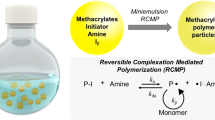Abstract
A reverse micellar system comprising dioctyl-sulfosuccinate (AOT)/toluene was used as a template for polymerization of acrylamide/bisacrylamide-based functionalized polymeric nanoparticles. Such nanoparticles were typically sized between 20 and 90 nm and could be synthesized with a wide range of functional groups according to the monomers added to the polymerization mixture. Carboxy nanoparticles with acrylic acid as the functional monomer were synthesized in the reported work. The carboxy nanoparticles were pH sensitive and precipitated at pHs below 4. Modification of carboxy-functionalized polymeric nanoparticles with polyetheleneimine (PEI) resulted in the fabrication of a series of pH-responsive nanoparticles which could precipitate at different pHs and ionic strengths according to the PEI/carboxy ratio in the system. Both non-covalent PEI-nanoparticles conjugates and nanoparticles with covalently linked PEI behaved in this way.






Similar content being viewed by others
References
Arizaga A, Ibarz G, Piñol R (2010) Stimuli-responsive poly(4-vinyl pyridine) hydrogel nanoparticles: synthesis by nanoprecipitation and swelling behavior. J Colloid Interface Sci 348:668–672. doi:10.1016/j.jcis.2010.05.051
Bae YH (1997) In: Park K (ed) Controlled drug delivery challenges and strategies. ACS, Washington, DC
Benoit JP, Couvreur P, Devissaguet JP, Fessi H, Puisieux F, Roblot-Treupel L (1986) Les formes vectorisées ou distribution modulée, nouveuax sistèmes d’administration medicaments. J Pharm Belg 41:319–329
Filippov S, Hruby M, Konak C, Mackova H, Spirkova M, Stepanek P (2008) Novel pH-responsive nanoparticles. Langmuir 24:9295–9301. doi:10.1021/la801472x
Fujii M, Taniguchi M (1991) Application of reversibly soluble polymers in bioprocessing. Trends Biotechnol 9:191–196. doi:10.1016/0167-7799(91)90062-M
Galaev IY, Mattiasson B (1999) ‘Smart’ polymers and what they could do in biotechnology and medicine. Trends Biotechnol 17:335–340. doi:10.1016/S0167-7799(99)01345-1
Galaev IY, Gupta MN, Mattiasson B (1996) Use smart polymers for bioseparations. ChemTech 12:19–25
Guoquiang D, Batra R, Kaul R, Gupta MN, Mattiassion B (1995) Alternative modes of precipitation of Eudragit S 100: a potential ligand carrier for affinity precipitation of protein. Bioseparation 5:339–350
Gurny R, Junginger HE, Pulsatile PN (1993) Drug delivery: current applications and future trends. Wissenschaftliche Verlagsgesellschaft, Stuttgart
Hui CL, Li XG, Hsing IM (2005) Well-dispersed surfactant-stabilized Pt/C nanocatalysts for fuel cell application: dispersion control and surfactant removal. Electrochim Acta 51:711–719. doi:10.1016/j.electacta.2005.05.024
Kumar A, Srivastava A, Galaev IY, Mattiasson B (2007) Smart polymers: physical forms and bioengineering applications. Prog Polym Sci 32:1205–1237. doi:10.1016/j.progpolymsci.2007.05.003
Langer R (1998) Drug delivery and targeting. Nature 392(Suppl.):5–10
Martin GR, Jain RK (1994) Noninvasive measurement of interstitial pH profiles in normal and neoplastic tissue using fluorescence ratio imaging microscopy. Cancer Res 54:5670–5674
McClean S, Prosser E, Meehan E, O’Malley D, Clarke N, Ramtoola Z (1998) Binding and uptake of biodegradable poly-dl-lactide micro- and nanoparticles in intestinal epithelia. Eur J Pharm Sci 6:153–163. doi:10.1016/S0928-0987(97)10007-0
Medeiros SF, Santos AM, Fessi H, Elaissari A (2011) Stimuli-responsive magnetic particles for biomedical applications. Int J Pharm 403:139–161. doi:10.1016/j.ijpharm.2010.10.011
Morrison RT, Boyd RN (1992) Organic Chemistry, 6th edn. Prentice-Hall Inc, New Jersey
Motornov M, Roiter Y, Tokarev I, Minko S (2010) Stimuli-responsive nanoparticles, nanogels and capsules for integrated multifunctional intelligent systems. Prog Polym Sci 35:174–211. doi:10.1016/j.progpolymsci.2009.10.004
Qiu Y, Park K (2001) Environment-sensitive hydrogels for drug delivery. Adv Drug Deliv Rev 53:321–339. doi:10.1016/S0169-409X(01)00203-4
Sahoo SK, De TK, Ghosh PK, Maitra A (1998) pH- and Thermo-sensitive Hydrogel Nanoparticles. J Colloid Interface Sci 206:361–368
Sherwood L (1997) Human physiology from cells to systems, 3rd edn. Wadsworth Publishing Company, Belmont, pp 121–165
Soppimath KS, Aminabhavi TM, Kulkarni AR, Rudzinski WE (2001) Biodegradable polymeric nanoparticles as drug delivery devices. J Control Release 70:1–20. doi:10.1016/S0168-3659(00)00339-4
Vakurov A, Pchelintsev N, Forde J, O’Fagain C, Gibson T, Millner PA (2009) The preparation of size-controlled functionalized polymeric nanoparticles in micelles. Nanotechnology 20:295605. doi:10.1088/0957-4484/20/29/295605
Valeur B, Keh E (1979) Determination of the hydrodynamic volume of inverted micelles containing water by the fluorescent polarization technique. J Phys Chem 83:3305–3307. doi:10.1021/j100488a025
Wu XY, Zhang Q, Arshady R (2003) Stimuli sensitive hydrogels. Polymer structure and phase transition. In: Arshady R (ed) Polymeric biomaterials. Citus Books, London
Zhang K, Wu XY (2004) Temperature and pH-responsive polymeric composite membranes for controlled delivery of proteins and peptides. Biomaterials 25:5281–5291. doi:10.1016/j.biomaterials.2003.12.032
Acknowledgments
The work reported has been carried out with financial assistance from the EC, project COMBIO (contract COOP-CT-2006-032628). We thank the Electron Microscopy Unit at Michael Smith Building of Manchester University, and Roger Meadows for performing the freeze-fracture of nanoparticles samples.
Author information
Authors and Affiliations
Corresponding authors
Rights and permissions
About this article
Cite this article
Vakurov, A., Pchelintsev, N.A., Gibson, T. et al. Development of polymeric nanoparticles showing tuneable pH-responsive precipitation. J Nanopart Res 14, 1302 (2012). https://doi.org/10.1007/s11051-012-1302-x
Received:
Accepted:
Published:
DOI: https://doi.org/10.1007/s11051-012-1302-x




